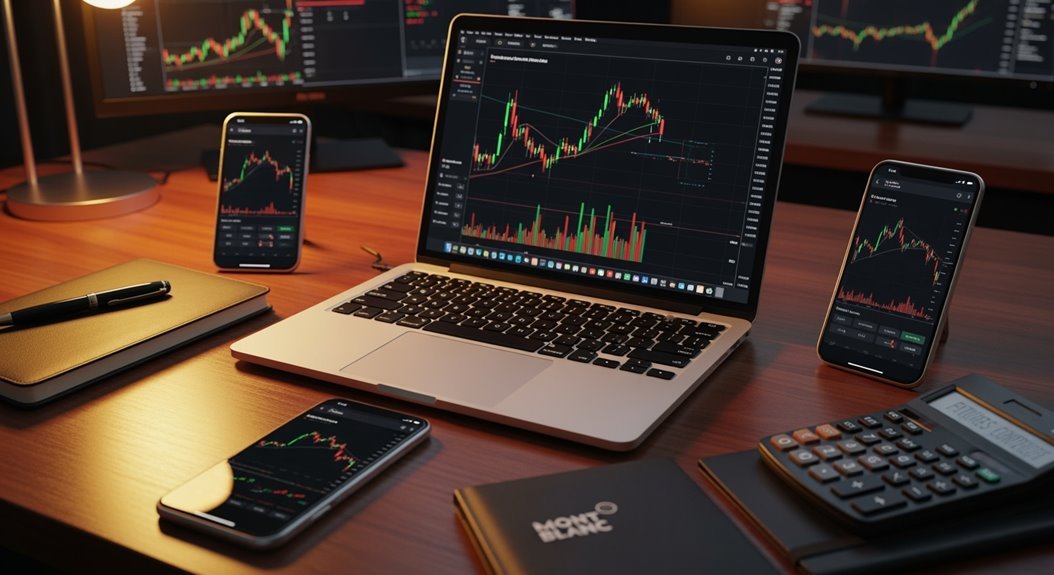Contract trading enables investors to speculate on cryptocurrency price movements without owning the underlying assets. These derivative instruments include futures with set expiration dates, perpetual contracts that never expire, and options providing asymmetric risk exposure. Traders can leverage positions to amplify potential gains while managing portfolio risk through hedging strategies. The 24/7 markets offer enhanced liquidity and capital efficiency compared to spot trading. However, volatility and leverage create significant risks requiring disciplined management techniques.
Contract Trading Fundamentals and Market Mechanics

While traditional crypto trading involves buying and holding digital assets, contract trading flips this concept entirely. Traders speculate on price movements without owning the underlying cryptocurrency.
These derivative contracts create agreements between two parties. One bets prices will rise. The other expects them to fall. It’s a zero-sum game—someone’s profit equals another’s loss.
Leverage amplifies everything. Small capital controls massive positions. Bigger potential gains. Bigger potential losses. Risk scales proportionally.
Contracts function differently than spot trading. Pricing depends on the underlying asset price, time until expiration, volatility, and market sentiment. Traders can close positions early by transferring them to other market participants.
This flexibility attracts speculators and hedgers alike. Speculators chase leveraged profits. Hedgers protect existing crypto holdings against adverse price movements. Both avoid the complexities of actual cryptocurrency ownership while maintaining market exposure. Trading platforms typically charge fees as low as 0.01% for these derivative transactions.
Contract traders must maintain margin requirements to keep their positions open and prevent forced liquidation. Contracts can be structured with a strike price that determines the fixed price for executing the underlying asset transaction.
The mechanics are straightforward. The risks are magnified.
Types of Crypto Derivatives: Futures, Perpetuals, and Options
Three primary derivative types dominate crypto contract trading: futures, perpetuals, and options. Each serves distinct purposes.
Crypto futures are straightforward agreements. Traders buy or sell cryptocurrency at predetermined prices on set future dates. They’re perfect for speculation and hedging. But there’s a catch—expiration dates force settlement through asset delivery or cash.
Perpetual futures changed the game entirely. No expiration dates. Ever. Traders can hold positions indefinitely. The secret? Funding rates. These periodic payments between traders keep contract prices anchored near spot prices. It’s crypto’s unique innovation.
Options offer something different: choice. Buyers get the right—not obligation—to buy or sell at strike prices. Call options for buying. Put options for selling. The asymmetric risk appeals to many traders.
Options give traders the power to choose without obligation—asymmetric risk that limits losses while preserving unlimited upside potential.
All three require margin accounts. All amplify gains and losses through leverage. Major exchanges like Binance and CME Group facilitate trading across different platforms. The key difference? Risk profiles and settlement mechanics vary dramatically between each type. Most futures contracts are offset to avoid delivery, which is often inconvenient for traders. Effective risk management proves essential given the speculative nature of these derivative contracts.
Benefits and Strategic Advantages of Derivative Trading
Beyond simple speculation, crypto derivatives reveal strategic advantages that reshape how traders approach digital asset markets. These instruments release liquidity that spot markets often lack. Traders execute large positions quickly. Price impact stays minimal.
Portfolio diversification becomes sophisticated. Options and futures enable directional and non-directional strategies. Short selling works without owning underlying assets. Risk spreads across multiple exposures.
Leverage amplifies capital efficiency dramatically. Small accounts control substantial positions. Volatile crypto moves translate into magnified profits. But losses amplify equally. Margin calls lurk.
The 24/7 trading cycle never stops. Global events trigger immediate responses. No market closure interruptions. Different time zones participate freely.
Risk management improves through hedging strategies. Price locks protect against volatility. Stop-loss orders limit downside exposure. Operational risks decrease since direct crypto handling becomes unnecessary. Transactional fees remain significantly lower compared to traditional spot trading methods. Trading platforms deploy security services to prevent online attacks and protect user accounts from malicious activities.
Derivatives attract diverse market participants. This creates deeper liquidity pools. Price stability increases. Market efficiency improves across the board. Institutional investors gain exposure to price movements while implementing sophisticated hedging strategies without requiring direct cryptocurrency ownership.
Risk Management and Platform Considerations

Successful crypto derivatives trading hinges on rigorous risk management protocols that most traders overlook. Stop-loss orders automatically close positions at predetermined levels. They’re essential. Position sizing matters more—risking only 1-2% of total capital per trade prevents devastating losses from single events.
Platform selection proves equally critical. Traders need reliable exchanges with strong uptime and fast execution speeds. Slippage kills profits. Security features like robust custody solutions and encryption protect against hacks. Exchange due diligence means verifying licensing and regulatory compliance before depositing funds.
Quantitative approaches enhance decision-making. Monitoring basis spreads reveals arbitrage opportunities and risk signals between spot and futures prices. Leverage ratios require constant tracking to avoid liquidation risks inherent in derivatives trading. Understanding funding rates helps traders assess the periodic costs of holding perpetual futures positions and their impact on overall profitability. Market manipulation through coordinated whale activities can create false price signals that trap retail traders.
Emotional discipline separates successful traders from failures. Sticking to predefined stop-loss levels prevents loss-chasing behavior. Avoiding overleveraging and hype-driven positions maintains long-term consistency. Structured trading plans incorporating strict risk limits help mitigate behavioral biases that destroy portfolios. Cold storage wallets provide additional security for significant holdings that aren’t actively traded in derivatives positions.
Frequently Asked Questions
What Are the Tax Implications of Crypto Contract Trading Profits and Losses?
Crypto contract trading profits face capital gains tax when positions close. Short-term gains get taxed as ordinary income at rates up to 37%. Long-term holdings enjoy reduced rates between 0-20%. Losses offset gains, reducing tax liability. Traders must report on Form 8949 and Schedule D. Income from staking or mining counts as ordinary income. Accurate record-keeping proves essential for IRS compliance and audit protection.
How Much Initial Capital Do I Need to Start Contract Trading?
Initial capital requirements vary dramatically by platform and leverage choice. Minimum deposits start around $10-$100, but realistic contract trading needs several hundred dollars. Higher leverage reduces upfront capital but increases liquidation risk. A $1,000 margin controls $10,000 with 10x leverage. Smart traders follow the 1-2% risk rule per trade, meaning practical capital requirements exceed basic margin minimums for safe trading.
Can I Trade Crypto Derivatives if I’m a Beginner Trader?
Beginners can trade crypto derivatives, but experts strongly advise against it. The learning curve is steep. Leverage amplifies losses dramatically—sometimes beyond initial investments. Complex contract terms, margin requirements, and technical analysis skills create significant barriers. Most platforms offer demo accounts for practice. Smart beginners start with spot trading first. Build experience gradually. High volatility and liquidation risks make derivatives unsuitable for inexperienced traders.
What Happens to My Contracts During Major Market Crashes or Flash Crashes?
During major crashes, contracts face forced liquidation when margin requirements aren’t met. Leveraged positions get automatically closed, often at significant losses. High leverage traders suffer most – those using 10x leverage are extremely vulnerable. Cascading liquidations create waterfall effects, driving prices down further. Recent crashes saw nearly $1 billion liquidated in 24 hours. Long positions betting on price increases get hit hardest as markets plummet rapidly.
Are Crypto Derivatives Legal in My Country or State?
Crypto derivatives legality varies greatly by jurisdiction. The US, EU, Japan, Singapore, and Australia permit trading under strict regulatory frameworks. China, India, Russia, and Turkey impose bans or severe restrictions. Licensing requirements differ considerably. Some countries like Portugal offer tax advantages, while others heavily tax gains. Traders must verify local regulations through financial authorities. Legal status changes frequently as governments adapt policies. Compliance requirements vary between institutional and retail traders.



